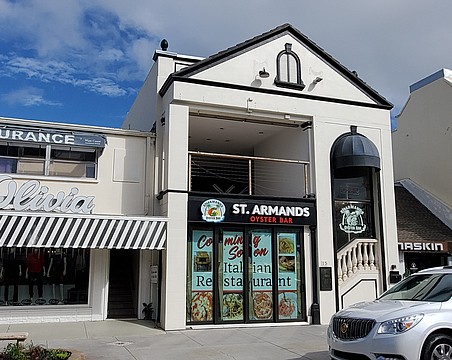The decision-making process for Maj. Gen. Karl Horst is different from just about every other leader and top executive on the Gulf Coast.
That's because for Horst, based out of U.S. Central Command at MacDill Air Force Base in Tampa, decisions have a life-and-death impact. Known as Centcom, Central Command is responsible for planning and operating missions in 20 countries in the central area of the globe. The command includes Afghanistan, Iran and Iraq.
“Every day I come in, I'm faced with new challenges,” says Horst. The challenges are lethal and strategic.”
Horst is the chief of the Centcom staff. That makes him the third-most senior officer in the headquarters. Horst, who joined the U.S. Army in 1973 and graduated from the U.S. Military Academy in West Point in 1978, is also the senior ranking Army officer at Centcom.
Horst held a variety of positions before his Centcom appointment last July, including a stint commanding a battalion and a brigade in the Army's famed 82nd Airborne Division. A second-generation American from German descent, whose father enlisted in the U.S. Navy, Horst served in combat in Operation Iraqi Freedom. He's won four medals for service, including a bronze star.
Horst recently sat down with the Business Review to talk about leadership and decision-making. Here's an edited transcript of the conversation.
Q. What are the qualities you look for in a leader?
A. The quality of character to a large extent defines a good leader. Good leaders are value-based. A leader must know his strength and weaknesses, and know that no leader has all strengths and no weaknesses. A leader has to have confidence, but not arrogance. You have to have humility.
Q. What types of leaders do you admire?
A. I look for integrity. If you don't tell the truth, and I can't trust you, then you cannot lead me and I will not follow you. I admire leaders who lead by personal example, not from the back, but from the front.
Q. Who are your leadership mentors?
A. Retired Gen. Gordon Sullivan was the (ultimate) leader in my mind. He's extraordinarily competent and visionary, yet equally extraordinarily humble and compassionate. He treated junior soldiers with the same degree of dignity and respect as his fellow four-stars. (Sullivan was chief of staff of the U.S. Army and a member of the Joint Chiefs of Staff.)
Gen. Jim Mattis (who replaced Centcom commander Gen. David Petraeus in 2010) is the most competent and most learned officer in the art of war on active duty today. He's absolutely peerless in that regard. He has dedicated his life to the Marine Corps and the United States and is the embodiment of the selfless servant. And my wife, Nancy Horst, I admire her for her leadership.
Q. How did you develop your leadership skills?
A. I learned my leadership by playing team sports. I played baseball, football and hockey. The lessons you learn in little league, Pop Warner football and peewee hockey are things that help you grow into a leader.
Q. What is an underappreciated characteristic of a good leader?
A. You have to read back (instructions.) You have to give confirmation briefs. Then you have to follow up to make sure it has been done. You have to check, check, check. I use the theory of Auftragstaktik, which is mission-type-actions. (The battlefield theory is credited partially to Helmuth von Moltke, a 19th century German Field Marshall. The theory holds that the unknowns of war make it a necessity that solders think independently to accomplish the mission. In the U.S. military, some leaders do this when they issue an order to a lower unit that encompasses the entire mission.)
Q. What kind of leader is better — a cheerleader or someone who motivates through fear?
A. A lot of my leadership is based on positive mentors and positive experiences. But I've also had some negative experiences. I've had some leaders where I've said to myself that if I ever get to be in a position like that, I will never do what that person did. You can learn as much from a bad leader as a good leader. You just have to have the wherewithal to know the difference.
Q. What leadership books do you recommend to aspiring leaders?
A. If you subscribe to the theory that leadership is an art, not a science, which I do, than “Leadership Jazz,” by Max DePree, is a great book. Jazz musicians don't train as jazz musicians, they train as classical musicians and improvise with jazz. In leadership you need to interpolate all kinds of styles. My leadership style can't be like someone else's. Another great book is “Leadership Secrets of Attila the Hun,” by Wess Roberts.
Q. Are there natural-born leaders?
A. Some people are natural-born leaders. For others it's a learned skill. I'm not a natural leader. I believe my leadership was learned through study and mentors. (President) Bill Clinton was a natural leader because he was such a charismatic guy who was able to persuade people based on his words. President Barack Obama also has that ability. Grant, Eisenhower and Washington were like that, too.
Q. How do you make decisions under pressure?
A. You have to categorize what kind of pressure it is. In combat, when lives are at stake, it boils down to what your instincts are. The margin for error is very short.
In non-combat decisions, you have more time for a formal analysis. In making a decision in non-combat, I look at a series of things. First, it's what's at stake? Second, is what are the options? It's usually not a 'yes' or 'no' decision. Third, I ask who will benefit from the decision, who is disadvantaged from it, and how this decision will reflect on the organization. Then I look if it's moral and legally correct, how much it costs and if we can afford it. Then I look at what the impact is of not making a decision, because deciding not to do anything is a decision within itself.
Q. What is your personal approach to decision making?
A. I do reflective thinking. This morning I went for a run and thought about the notes I had written for this interview. Sometimes you have to go to a quiet place and close the door and turn off the music. I also write down what's at stake. I will also use my wife as a sounding board.
Q. How can military culture translate to business?
A. It's kind of difficult to say, because I've only been a solider, I've never been a businessman. But I think it's a very logical transition. All the qualities for someone in uniform should go for someone in a multi-colored tie or a dress.
DECISION TIME
Maj. Gen. Karl Horst has made thousands of decisions in a 39-year U.S. Army career — a large chunk of which has been in leadership positions.
Horst now lives and works in Tampa, where he's the senior U.S. Army officer and third-most senior officer at U.S. Central Command. The decisions he makes there range from budget to personnel to policy. But he's also made several combat decisions, including two memorable ones during Operation Iraqi Freedom. One was notable because it worked out, while the other one was notable for what went wrong.
The good
Horst led four Humvees packed with soldiers through Baghdad in October 2005, when the fourth and final vehicle in the convoy got a flat tire on a bridge.
The other three vehicles had already crossed the bridge, which spanned a canal. The soldiers on the fourth Humvee, the one with the flat, were anxious to fix it and catch up.
But Horst sought to provide cover for the now isolated tire changers. So he ordered the first three Humvees to turn around and go back over the bridge.
The decision was a lifesaver, it turned out, when the squad was ambushed.
“In the middle of changing the tire, we were attacked on two sides,” says Horst. “Had we not brought the vehicles back to the other side of the canal, there would have been casualties. Instinctively, I knew not to let the other truck just sit there. We were able to defeat the enemy without any casualties.”
The bad
Another time in Baghdad, in August 2005, Horst led a reconnaissance mission from the air that consisted of two UH60 Blackhawk helicopters and two AH64 Apache helicopters.
Horst was a passenger in one of the Blackhawks when he heard about a nearby IED explosion, where U.S. soldiers were under attack. The Blackhawk is a tactical transport helicopter not known for firepower, while the Apache is a twin-engine helicopter designed specifically to attack.
Still, Horst says he “went to where the guns were.” He ordered the pilots to break off the reconnaissance mission and assist in the firefight. But the Blackhawks got there significantly before the two Apache helicopters arrived. Says Horst: “We flew right into a ground ambush.”
The helicopter Horst was in was shot up, and the pilot was injured. Horst was not hit with bullets, but he does regret the decision he made. “I should have directed the Apaches to go first and clean up the area,” Horst says. “The lesser armed aircraft flew into a pretty substantial ambush.”
Adds Horst: “I wish I had that decision back again.”






